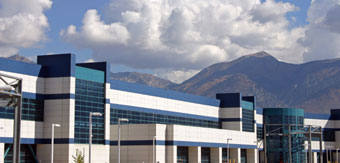SEMICONDUCTOR & ELECTRONICS
Chips Come Home
This inclination to go where you know is part of what's making the U.S. interesting again for semiconductors. What such firms need are found in locations like Northern Virginia, known for its business-friendly environment, highly educated pool of workers, world-class schools and universities, and access to the corridors of power and rich cultural offerings of Washington, D.C.
When Micron and Intel teamed up to produce a 12-inch wafer for NAND memory, Manassas, just outside the Beltway that encircles the D.C. metro area, was a logical choice, Otte says. "It was sort of a no-brainer, because we already owned the facility, and it was not at capacity. And we were really looking for speed-to-market." Re-tooling an existing facility shaved off a full year in pre-production preparation, Otte says. An educated labor force and nearby amenities were powerful lures as well.
 |
| Micron isn't the only big semiconductor maker putting its chips on Virginia. Infineon (left in the aerial above) has gone forward with a major investment at White Oak Technology Park in Henrico County. That's HP's campus on the right, with plenty of room for more. |
Other states have seen a significant uptick in activity as well. Arizona, for example, beat out traditional contender Ireland for Intel's new $3.5 billion fab plant.
Compared to Texas – home to Dell, Texas Instruments, Alcatel USA, Freescale Semiconductor and Advanced Micro Devices – these announcements in other states equate to the proverbial drop in the bucket. In 2005, Texas exported a whopping $31.14 billion worth of computer and electronics equipment. This figure is down from 2004, but experts speculate that the number will climb again in 2006, as some of the major players add new capacity to Texas facilities.
Austin, for example, is flying high on the heels of Samsung's blockbuster announcement to build a $4-billion fab there. This decision makes it easier for city fathers and mothers to say goodbye to some of Dell's Round Rock capacity, as the struggling computer company moves design and development to India and Malaysia as a cost-cutting measure.
Like many firms, the Micron/Intel joint venture, called IM Flash, isn't limiting its location strategy to just one state. Demand is so strong
 |
| Micron's sites in Lehi, Utah (above), and Boise, Idaho, will benefit from the chip maker's joint venture with Intel, which aims to spread a total of $5 billion in investment across several different locations. |
"Lehi is the shell of a state-of-the-art building that Micron built in the mid-90s," Micron spokesman Daniel Francisco explains. "With the bad downturn that occurred, the building only had limited operations. Now we are dedicating the whole facility to flash, with a goal of being fully operational by early '07," he says. Micron's home base of Boise, Idaho will also see added investment.
Advance orders for the flash memory are very strong, according to Francisco, with a new contract to supply Apple Computer. Apple hasn't been able to stock enough of its wildly popular iPods because of flash memory shortages, making the coveted teen and twenty-something demographic a tad unhappy. Apple is paying $250 million each to Micron and to Intel up front for supply so that Apple can guarantee a steady flow, according to published reports.
Together, Micron and Intel are investing $5 billion across the three facilities. "The reason we are together on this is that we want to become bigger and better" than the other competitors in the space, Francisco explains.

